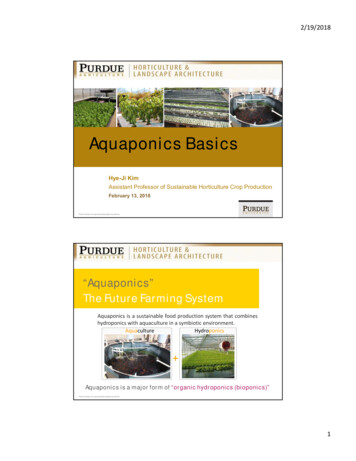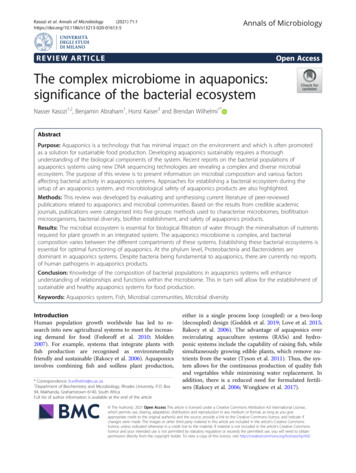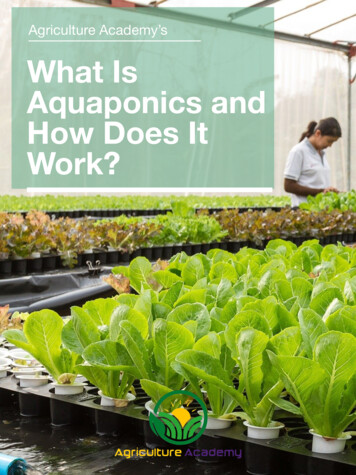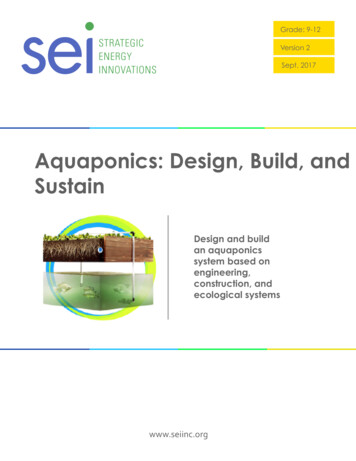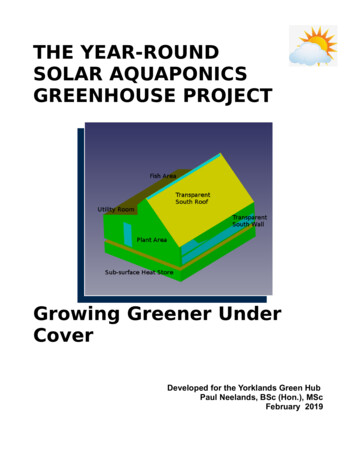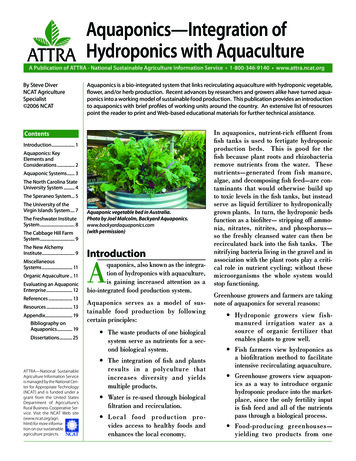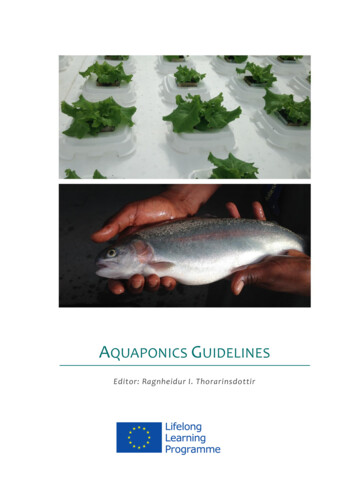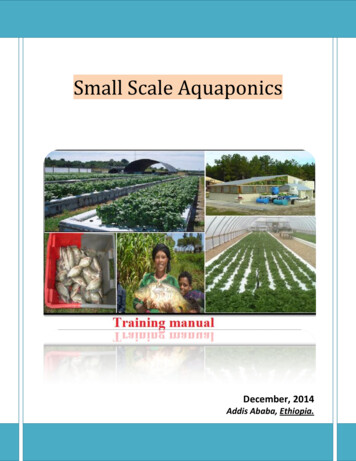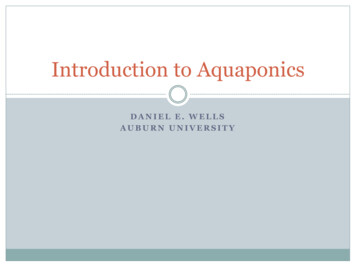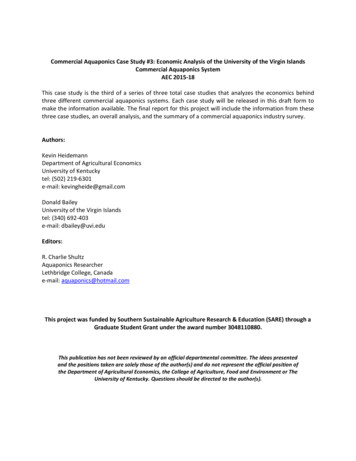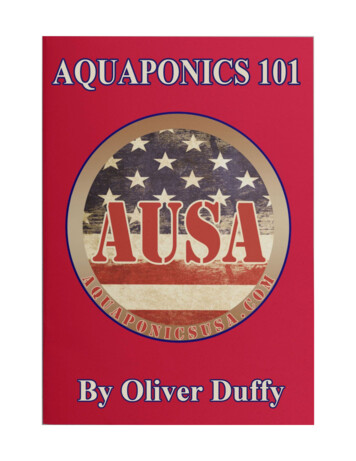
Transcription
2
3
Aquaponics 101 Introduction:We, here at Aquaponics USA, receive calls daily from Aquaponics enthusiasts withvarying amounts of Aquaponics experience. Most are very new to this wonderfultechnology. When we first started out in late 2008, we were also new to Aquaponicsand had to learn. Fortunately, we had lots of help on Murray Hallam’s Australian forumfrom those more experienced folks; and, of course, Murray himself, who was a greatmentor. Once we felt we had enough information we started to build our own systemand that is where the learning really began.Being a retierd Aerospace Engineer with over 45 years of experience in many aspectsof that industry was beneficial in understanding and implementing the various designsI came up with and also understanding what went wrong when things didn’t work theway I expected.What follows is going to teach you most of what you will need to know aboutAquaponics in order to build and maintain your own system. So, if you're curious aboutthe most amazing food growing technology on the planet today, read and take noteson the numbers presented as they collectively are what is most important for you tobuild a properly designed Aquaponics (AP) system.This was originally written to address those who are of the belief that we are about tosee some serious changes in our economy, along with the price and availability offood. With this in mind, I felt it was time to write this primer as Aquaponics 101 so thatthose who wish to prepare could have a year-round capability for helping to feedthemselves and their family.As this tutorial progresses, I will be talking about family and school-sized systems andfocusing on the type that we know best. I realize that there are a number of viableapproaches to building AP systems that many Aquaponics pioneers haveexperimented with and developed. Due to this emerging technology, there are manydiffering opinions held by those involved with this wonderful gift of nature. I can onlytell you what I believe to be true from all that I have read about other's efforts and frommy own experience.Historically speaking, Aquaponics as a technology has been around for hundreds ofyears; but ironically, it also is still in its infancy as a family and school food growingtechnology. There is much research yet to do in this area and much to learn.This information is aimed at those who want to build or purchase and run their firstsystem and have the best chance of it working well and producing food.4
5
Aquaponics 101 Part 1: The Bio-Chemical Process, an Introduction of theNitrogen CycleWhat is Aquaponics and why should I care?Aquaponics is an ancient food growing technology that has been around since theEarth has had water with fish and plants growing together naturally. Aquaponics isnature at work. In nature, the fish eat whatever they find for food, and their waste isbroken down by the bacteria in the water creating nutrients for the plants. The plantsthat receive that nutrient rich water then absorb these nutrients; and in doing so, theyhelp clean the water for the fish.The word "Aquaponics" comes from two separate words. The first word is “aqua",which, of course, means water; but in this case, the "aqua" is from another compoundword "aquaculture" (the raising of fish). The second word is "ponics", which is latin forwork, and comes from its use in "hydroponics" (working at growing plants in water,hydro).So, Aquaponics is raising fish and growing plants by using the nutrient rich waterprovided by the fish.The reason one should care about Aquaponics is that it is a year-round food growingtechnology, which can supply you and your family with fresh veggies and fishregardless of the season. Most fish species take a year or more to grow out to ediblesize. Because of this long term growth, the system must be placed in an environmentthat allows for year-round operation. In tropical climates, an Aquaponics (AP) systemcan work outside with minimum cover. In milder climates, it must be placed in anenvironmentally controlled green house. In harsh climates, it must be placed indoorswith grow lights to replace the sun and grow your plants.6
There were 5 Deep Media Grow Beds in our original Greenhouse System Design.Since these photos were taken, we have relocated and have a new Greenhouse.The plants grown in an AP system grow out in less time, grow year round, can beplanted more densely, are tastier and require 90% less water than does tillagefarming. Also, if the AP system is properly designed, it takes up much less space thandoes tillage farming. Some plants can be grown directly in the fish tank to absorb thenitrates from the water as any one who owns an aquarium knows. Most AP farmersseparate their fish tanks from their plant grow beds allowing them more flexibility in theway they grow and in what they grow. The water is circulated between the fish tankand the grow bed using a pump. This is known as a recirculating aquaculture systemthat contains two food sources, fish and vegetables. Some grow their fish for foodwhile others keep their fish as pets that also serve a useful purpose, which is fertilizingthe plants.But there is a third living organism in the AP equation, the beneficial bacteria. They arethe pro-biotic of the system and live in what is called a bio-filter. Just like the namesays, the pro-biotic (beneficial bacteria) filters the waste in the water, not by removingit, but by converting it into nitrates. Where this takes place could be called a bioconverter, but it is generally called a bio-filter instead.In an aquarium, where there are only a few fish for the amount of water, the bacterialive in the water, the sand on the aquarium bottom and on any surface where they canattach themselves. In an aquaponics system, the amount of fish per gallon of water ismuch higher than what is usually found in an aquarium. This higher fish densityrequires an additional amount of filtration; therefore, a bio-filter becomes an importantpart of the recirculating water path in the system.Before discussing bio-filtration, I want to address the concern some may have for thehigh density of fish in the system. In a home or school AP system, we are talking aboutone pound of fish for about every six gallons of water maximum at full fish growth.Commercial fish farmers usually run much higher densities, which requires specialfiltration and oxygenation of the water. Even at six gallons per pound of fish in thesystem, the fish tend to school together somewhat because it's the nature of fish tocreate schools. They were introduced into the same tank when the were very small,grew up together and like to hang out with each other. When fish get stressed, you willknow it by their unnatural behavior. At these densities, your fish will appear relaxedand healthy. I will be discussing the fish in much more detail in a later segment.7
The Nitrogen Cycle:The fish give off two types of waste, which, and if allowed to accumulate, is toxic tothem. As with any living organism, fish cannot live in their own accumulated waste.The first type of waste is ammonia, which is secreted from the gills and found in thefish urine. The second type is fish waste solids. We refer to this as fish effluent orcommonly called poo.The required bio-filter is a part of the AP system. In many systems, media filled growbeds double as the bio-filter because the media has a large amount of surface(substrate) area and the grow beds function not only as beds within which to grow theplants but also as a place where most of the bacteria in the system live that feed onthe ammonia. These bacteria, known as autotrophic bacteria, attach themselves toany surface they find. Their job is to convert the ammonia into nitrates.This is a two step process. First, one type of autotrophic bacteria converts theammonia to nitrites by splitting the ammonia into nitrogen and hydrogen. The nitrogen(N) is then combined with oxygen (O2) found in the water in the form of dissolvedoxygen and in this process forms nitrite (NO2). For the chemists reading this, it is NH3or NH4 O2 - NO2 H2. Both the nitrite and the hydrogen are released back intothe water.8
The nitrites (NO2) produced are also toxic to fish in relatively small quantities, just likethe ammonia. So, the second bacteria comes into play to add some more oxygen tothe nitrites converting them into nitrate (NO3). Note the spelling, nitrite (NO2), nitrate(NO3). Now, nitrates (NO3) are not very toxic to fish and generally, depending on thespecies of fish, they can tolerate 100 times more nitrates in the fish water than theycan ammonia or nitrites.Here's where an AP system becomes symbiotic (mutually beneficial). Plants need andlove (absorb) nitrates, so the nitrates won't stay or accumulate in the water to highlevels unless there are fewer plants than needed to absorb (uptake) all the nitratesgenerated by the fish and bacteria processes I just described.This brings us to the solid fish waste. The good news is that nature provides. In thiscase nature provides us with another type of bacteria known as heterotrophic bacteria.Heterotrophic bacteria live in the water and attach themselves to any dead organicmatter like uneaten fish food, dead plant roots or solid fish waste. Through a processcalled mineralization, the heterotrophic bacteria convert these leftovers into theircomponent parts, which then become nutrients for the plants. Heterotrophic bacteriaalso produce their own waste, which is more ammonia; and it is converted by theautotrophic bacteria mentioned above into nitrates for the plants. In addition,heterotrophic bacteria help keep the water in the fish tank clean and clear.Heterotrophic bacteria also require and consume the dissolved oxygen (DO) in thewater in order to live and do their work. So, heterotrophic bacteria take organicsuspended solids in the water and convert them to dissolved solids that can be utilizedby the plants while the heterotrophic bacteria consume dissolved oxygen (DO).It is important to note that the above processes each require and use DO found in thewater (as do the fish and plants) and deplete it from the water as they go about theirbusiness. This DO must be replaced on a continuous basis or the process will notwork properly. I will discuss the importance of ample DO in your system in a later part.The plants, which are planted in the grow beds, receive the nutrient rich watercontaining all these wonderful ingredients including DO, uptake them along with somewater and use them to grow. The remaining water now has reduced amounts ofnutrients, and it is returned to the fish tank for use by the fish. So, the fish are fed bythe AP farmer, and their waste feeds the bacteria. The bacteria convert their food (fishwaste) into bacteria waste that feeds the plants. The plants uptake the nutrient richfood provided by the bacteria. The water is cleaned in the process and returned to thefish. These symbiotic relationships are on-going as this is a recirculating aquaculturesystem that has both fish and plants as well as natures gift of beneficial bacteriaworking away, and it is known as Aquaponics.9
Congratulations! You've just completed Aquaponics 101 Part 1.Now it's time to test your knowledge. Take the Part 1 Quiz below:1. What is Aquaponics?2. How long does it take most edible fish species to Grow Out?3. In what climate can you set up an AP System with minimalcover?4. What is the Growing Season for Aquaponics fruits and veggieswhen the AP System is in a controlled Greenhouse?5. How much less water is used in Aquaponics farming comparedto tillage farming?6. Besides fish and plants, what is the general name of the thirdliving organism in an AP System?7. What are the names of the two types of this third livingorganism?8. Where do each of the two types of this third living organismlive in system?9. How many kinds of waste do fish give out?10. What are the names of these kinds of waste?11. Besides holding your plants, what second important role doMedia-filled Grow Beds play in an AP System?12. What is the name of the bacteria that converts ammonia intoNitrites?13. The fish can tolerate times more Nitrates than Nitritesand ammonia.14. Besides fish food, what needs to be replaced on a continuousbasis for the system to work properly?10
Aquaponics 101Part 2“I’m so pleased you decided to continue withyour Aquaponics 101 tutorials. After each partthere will be a Quiz Board so you can testyour knowledge.“If you missed the Quiz Board, you can goback to Part 1. If you're ready to move on,just start by reading and studying theinformation that follows.“Part 2 is all about System Design.”OLIVER11
Aquaponics 101 Part 2: The System DesignThis is the second in a series of Tutorials on Aquaponics 101 that are going to teachyou most of what you need to know about Aquaponics (AP). So, if you're curious aboutthe most amazing food growing technology on the planet today, keep reading.In Part 1, "The Bio-Chemical Process", I talked about what Aquaponics is and why it isimportant to Preppers (those preparing for what is about to come down the pike).To quickly review, Aquaponics combines the raising of fish and using the fish waste asplant nutrients so you can grow vegetables. This is done year-round and can providefood fish and veggies for your family.The bio-chemical process includes the breakdown of fish waste into plant nutrients,the uptake of these nutrients by the plants being grown in separate grow beds and thecleaning of the water to be returned to the fish tank and reused in an endless loop.This is all done in a continuous flow recirculating aquaculture system calledAquaponics.I'm now going to focus on a particular AP system type and its design, but I'll also bereferring to other designs. As mentioned in Part 1, the fish tank and grow beds areseparate entities. This precludes growing the majority of your vegetables directly in thefish tank. However, some green leafy plants like lettuce can be grown on rafts floatingin the fish tank as long as the particular fish being raised don't eat the plant roots.However, this is generally not done and tilapia love plant roots.As I also mentioned in Part 1, there is a need for a bio-filter, which is a part of thesystem; and it is filled with a media that contains lots of surface area on which thebacteria live. Most AP farmers (I'm talking about home and school farmers here)choose to combine their grow beds and their bio-filters into a single unit. Thissimplifies the design and construction of their AP system in addition to saving cost andspace. It is this combined system I will be focusing on here.12
This is our favorite media. It’s madefrom an expanded clay materialthat is pH neutral. (We’ll talk moreabout pH later in this tutorial)Hydroton is easy to work withbecause it is buoyant. When youneed to get roots out of yoursiphon, this becomes a realadvantage. So is the fact that it haslots of surface area.The combined grow bed/bio-filter containers (from here on referred to as grow beds)need to have enough volume to contain ample material with enough surface area tosupport the number of fish (by total weight) in the fish tank. They also must provideenough planting area to support the optimum amount of plants needed to uptake thenutrients without depleting the system of these nutrients, thereby causing poor plantgrowth. Seems complicated; but, fortunately, many have gone before us and haveworked this all out. We can build on their shoulders.Grow beds are generally filled with media, either expanded clay or smooth river stones(gravel), in order to give the needed surface area on which the bacteria thrive, whilesimultaneously holding the plants in place. The grow bed is filled with the media to alevel near the top of the grow bed container, and the fish tank water is pumped into thegrow bed filling it to a maximum level that is one inch below the top of the grow bedmedia. This one inch barrier is to prevent the top of the grow bed media frombecoming and staying wet, thereby preventing algae growth on the top of the media.This barrier also helps prevent the bottom leaves of plants in the grow bed frombecoming wet and moldy.The optimum grow bed container depth is about twelve inches. This will allow for atleast eleven inches of media and ten inches of fish tank water to be placed in it, whichis enough to provide for bacteria growth as well as providing ample depth for anythingyou wish to grow. It will also allow for some accumulation of fish solids in the bottom ofthe grow bed and give them time to break down before they over accumulate. Growbed containers deeper than 12 inches are more costly to fill with media, heavier andtransfer more water back to the fish tank (more on this later).Generally, deeper beds are unnecessary, unless you're using gravel as a grow bedmedia. Then, the extra depth can be beneficial (more on this later, also). Grow bedcontainers less than twelve inches deep cause your planting area to grow bed volumeratio to be less than ideal, thus creating more planting area than the bio-filter volumecan support (depending on what type of plants you have in the grow bed) and anaccumulation of fish waste in the shallow beds. This twelve inch number is not cast instone; but if you build a system using it, it will work. If you use other depths, especiallyless, then you are on your own. This is the basic design of all our Food Forever Growing Systems we build and sell.13
The size of the grow bed can be whatever you wish; but understand that if you go over30 inches in width, you will have difficulty reaching across it. For wider grow beds youwill need to have plenty of walk around room to get to two opposite sides. Forty eightinches is probably the maximum width you should be considering. The length is not asimportant as the depth and width. It is best to have at least two grow beds in yoursystem rather than just one. This will allow you to shut down one bed to clean out anyplant roots between plantings while still having your other grow bed working to keep thewater clean and safe for the fish.There are two different configurations of media-filled grow beds, flood and drain (alsocalled ebb and flow) and continuously flooded. Flood and drain are the best, regardlessof the types of plants you are planting, because it provides the best distribution ofincoming nutrient rich water throughout the bed as well as adding aeration to the wettedmedia and plant roots where the bacteria live. This also adds dissolved oxygen (DO) tothe water being flooded back into the bed and then returned to the fish tanks.You will need a way to flow the water into the grow bed. The water entry point into thegrow bed depends, in part, on the shape of your grow bed and how you plan on usingit. With a flood and drain grow bed, the point of entry of your water is not critical; but itshould have an unrestricted opening so as not to clog with fish waste solids. Do notattempt to spray your water into the grow bed, for the spray holes will clog up in shortorder (experience speaking here).Here is a great Bell Siphon that Idesigned and built for our Food Forever Growing Systems; and it works like acharm.One of the best features it offers is it'swide mouth, which is 4" in diameter. Thiswide mouth allows you to reach right intothe siphon and clean out any roots thatmay have taken up residence. It is alsoeasy to insert and remove the Stand Pipe.One of the best ways to drain your grow bed is with a Bell Siphon. This is a devicewith no moving parts that, when the grow bed is filled with water, starts to syphon outall of the water in the grow bed down to a preset level before "breaking siphon". At thatpoint, the siphon action stops; and the grow bed starts to refill. The design of thissyphon is critical in order to get it to do its job in a timely manner. I'm not going into thedesign and construction of Bell Siphons here. This information can be foundelsewhere on the web, as there are several different designs available. The siphonsmust be sized properly in order to remove the water from the grow bed in a fraction ofthe fill time it takes to fill the bed and still function properly. Grow beds using a BellSiphon have water continuously being flooded into them at a slower rate than thesyphon drains the water out, so you get a flood and drain cycling action. It is importantto have a continuous vertical drop (down hill all the way) of at least 6 inches (the morethe better) below the siphon so the water is drawn out of the grow bed.14
The more often you flood and drain your grow beds, the more dissolved oxygen will beadded to the water returning to your fish tank. You should count on cycling your growbeds at least four times per hour. Not only does the design of the syphon influence thecycle timing, the rate at which you flow water into your grow bed, does as well. Thiscycle timing is one of the most critical parts of the design of an AP system. Needless tosay, you will need enough pumping power to exchange most of the water in your growbeds four times an hour.Keep in mind that once the grow bed media is in the grow bed, it will displace at least50% (expanded clay) of the volume of the grow bed (more for gravel) leaving half orless of the original grow bed volume for water. This should be taken into account whensizing your water pump. The good news is, you may be able to use a smaller pumprequiring less electrical power as long as other pump sizing requirements are met(more on this in a later part).Within the AP community, you will find differing opinions on the numbers I'm about togive you; but I believe them to be the most accurate based upon what I have learnedfrom those with years of experience in building and testing different combinations ofsystem sizes and ratios, as well as from my own experience in verifying thesenumbers. You can build an AP system any size you desire, for it is the ratios of thevarious component sizes that really mater. So, lets start with the ratio of the fish tanksize in gallons to the grow bed container size in gallons. There should be about a oneto one ratio between the fish tank and grow bed container size. This is assuming thatyou are using media filled grow beds.15
Media filled grow beds are ones that use a growing media such as expanded clay orgravel to fill the beds. It has been found that the amount of grow bed volume neededto support a system is more related to the pounds of fish in the tanks and how muchthey are fed than the amount of water in the system. If you are using expanded clay asa grow bed media, a good rule of thumb for the size of grow beds is 6 gallons of growbed (minimum) container size for every pound of fish you plan to have in your systemat maximum fish grow-out size. If you plan on a ratio of six gallons of water per poundof fish in the fish tank, then this works out to about one gallon of fish tank capacity toone gallon of grow bed container capacity when using expanded clay as a grow bedmedia.Many AP farmers are pushing these numbers in their systems and will argue for whatthey are doing. I am trying to give you what I believe are optimum parameters here fora system that will have the highest probability of working and allow you the greatestpossibility of success as a first time AP farmer. Some live close to the edge and seemto get away with it, others are not so lucky.As to the difference between flood and drain grow beds and continuous flow growbeds, it is well known that some plants won't grow well or at all in constant flow growbeds; for their roots need more oxygen than do other plants. Flood and drain suppliesthis needed oxygen while constant flow does not. Logically then, the bacteria living inthe grow beds would do much better with more oxygen. We used to only flood anddrain for half of our grow beds and did continuous flow for the rest.That was when our DO (dissolved oxygen) in the water was low. Now we flood anddrain all of our media filled grow beds; and, along with the other changes, we havemuch better DO. It is just simple physics and logic that the water flowing through aconstant flow grow bed is not going to get as good of an even distribution of nutrientsand oxygen as a flood and drain grow bed, which does a nearly complete grow bedpurge with each cycle.Shown here is a DissolvedOxygen (DO) meter. Go to ourInstruments page foreverything you'll need to knowabout this handy (and from myperspective) much needed DOmeasuring device.DO Meters take theguesswork out of determiningwhat's going on in that veryimportant part of the BioChemical Process; and welloxygenated fish are happyfish.16
As to the grow bed depth, it is a number that has been tested by those who have beenworking with flood and drain aquaponics grow beds for many years. It has to do withthe surface area of the particular media with which you are working.One big debate is the removal of fish waste solids. Those who use deep (12" or more)grow beds generally find that they do not have a problem with over accumulation ofthese solids for a considerable amount of time. Those with shallower grow beds tendto complain about the accumulation of fish waste solids. I hedge my bets on this byweekly adding heterotrophic bacteria, and I will write about this product in a later part.After several years of running deep media grow beds, and yearly cleaning out justplant roots, I have found the solid fish waste problem not to be a big one. Around ourfifth year, we ran into some undissolved fish waste solids when planting and decidedthat completely cleaning the beds, meaning removing the Hydroton, washing it and thebed. Doing this about every year or two would be a good idea. This is a lowmaintenance recommendation for your deep media beds. I believe the deep mediabeds only need this minimal maintenance due to the depth of the grow beds allowingtime for the solids to break down and the abundance of dissolved oxygen as well asthe weekly adding of the Heterotrophic bacteria. If you follow this maintenance advice,when digging into the grow beds while they are flooded, you will find solids in thewater in the process of breaking down, but you will not find them accumulating in thebottom.There is a lot of research available that shows the importance of DO levels needed forboth plant and fish growth, and the science of nitrification clearly indicates itsnecessity. The flood and drain process also has been shown to increase oxygenationof the water in the grow bed, which gets returned to the fish tank.The deeper the grow beds, the more surface area there is for both the nitrificationprocess to take place as well as oxygenation of the wetted surface area of thesubstrate media in the grow bed. The oxygen only goes a few molecules deep into thewater surface, so the more surface area, the more oxygen is dissolved and eventuallyreturned to the fish tank.I need to impress the importance of high levels of DO in the system, for it is the primeingredient that is required in every aspect of the process. Anything that one can do inthe system design and operation to increase the DO will benefit the whole system.Unfortunately, this is usually mostly ignored, I believe, because of the cost of DOmeters. We are now offering a high quality and affordable DO Meter on our web site(AquaponicsUSA.com).17
Congratulations! You've just completed Aquaponics 101, Part 2.Now it's time to test your knowledge. Take the Part 2 Quiz here:1. Why can't you grow your AP lettuce in a fish tank full of tilapia?2. The most simplified AP System combines the andthe into a single unit.3. Since you're not using soil in an AP System, what do you place inyour grow beds?4. There are two main reasons you want the water in your growbed to be 1 inch below the top of the media. What are they?5. What is the optimum grow bed container depth?6. What's the disadvantage of using shallower than optimum mediagrow bed depth?7. Why is it best to have at least 2 deep media beds instead of justone in your AP system.8. What are the two types of media in media filled grow beds?9. Of the two types of media filled grow beds, which one issuperior and why?10. Why should you not attempt to spray the recirculating water intoyour grow beds?11. What is one of the best ways to drain a flood and drain growbed.12. The more often you flood and drain your grow beds, themore will be added to the water returning to your fishtank.13. If you're using media filled grow beds, you need to have aratio between the fish tank size and the grow bed size.14. A complete cleaning of deep media grow beds, meaning emptyingthem and cleaning the media and the bed should take placeabout every years.18
Aquaponics 101Part 3Part 3 is a Continuation ofPart 2You're moving along nicely. How are youdoing on those Quizzes? This Part isactually a continuation of Part 2, SystemDesign. There are many factors you have totake into consideration regarding yourSystem Design because all of thecomponents are interconnected. If one piecegoes out of whack, your system fails.OLIVER19
Aquaponics 101 Part 3: The System Design ContinuedThis is Part 3 in a series of tutorials that are going to teach you most of what you needto know about Aquaponics.Some will argue that the standard ratio of grow bed size to fish tank size is two gallonsof grow bed container capacity to one gallon of fish tank capacity instead of the one toone ratio I mentioned in Part 2. Again, the number for expanded clay is 1:1 and forgravel about 1.3:1 gallons of grow bed container capacity to fish tank capacity. Thereason for this one to one ratio limitation is that the water in the fish tank goes up anddown during the grow bed's flood and drain process, and too much variation in waterheight can stress the fish. You can use the 2:1 number only if you flood and drainsome of your grow beds but not all; or if you add a sump tank
So, Aquaponics is raising fish and growing plants by using the nutrient rich water provided by the fish. The reason one should care about Aquaponics is that it is a year-round food growing technology, which can supply you and your family with fresh veggies and fish regardless of the season. Most fish species take a year or more to grow out to .
